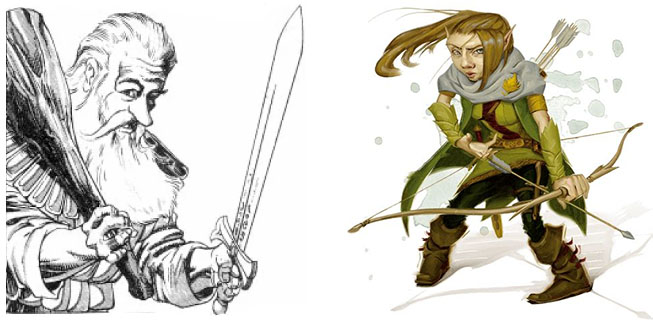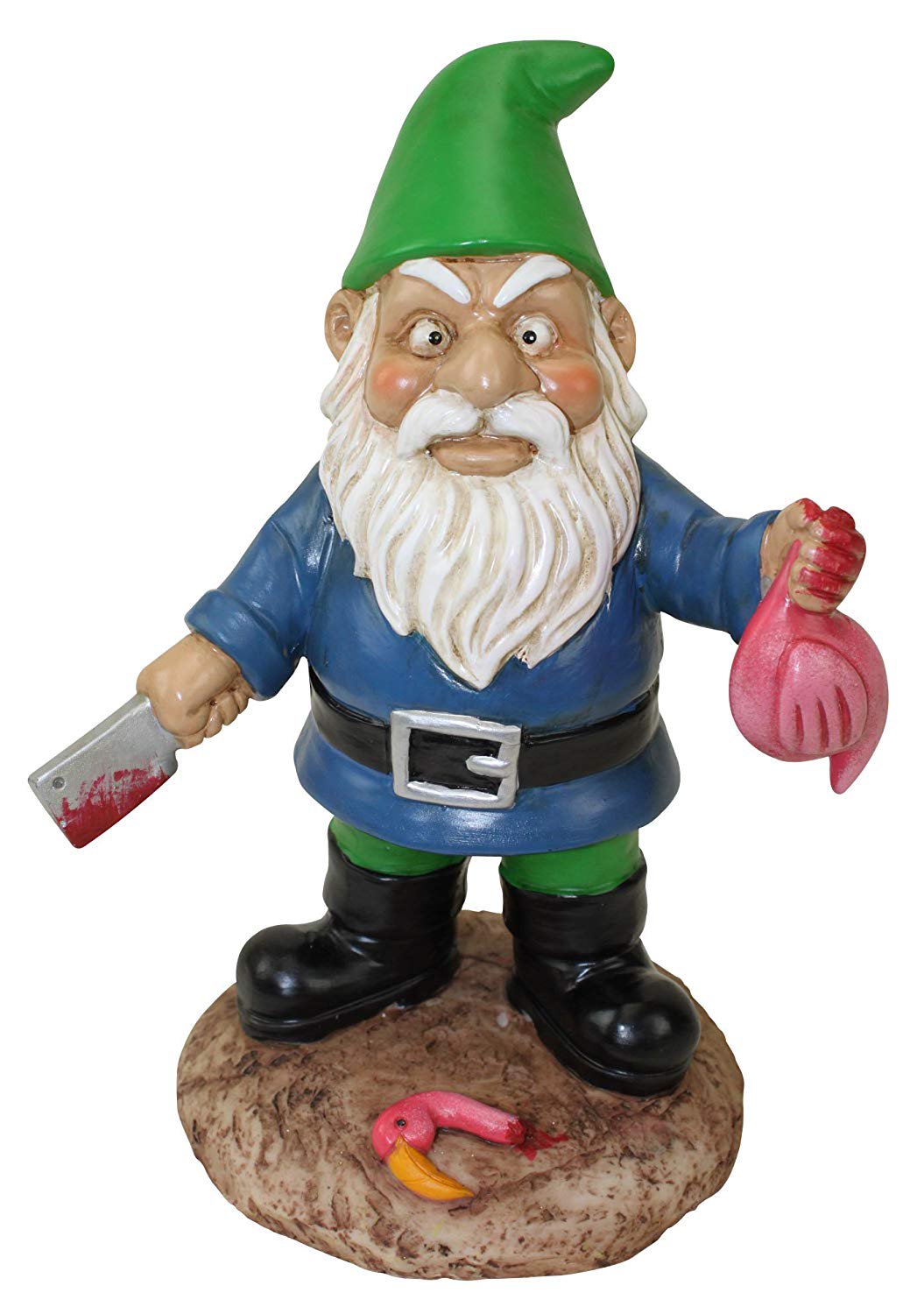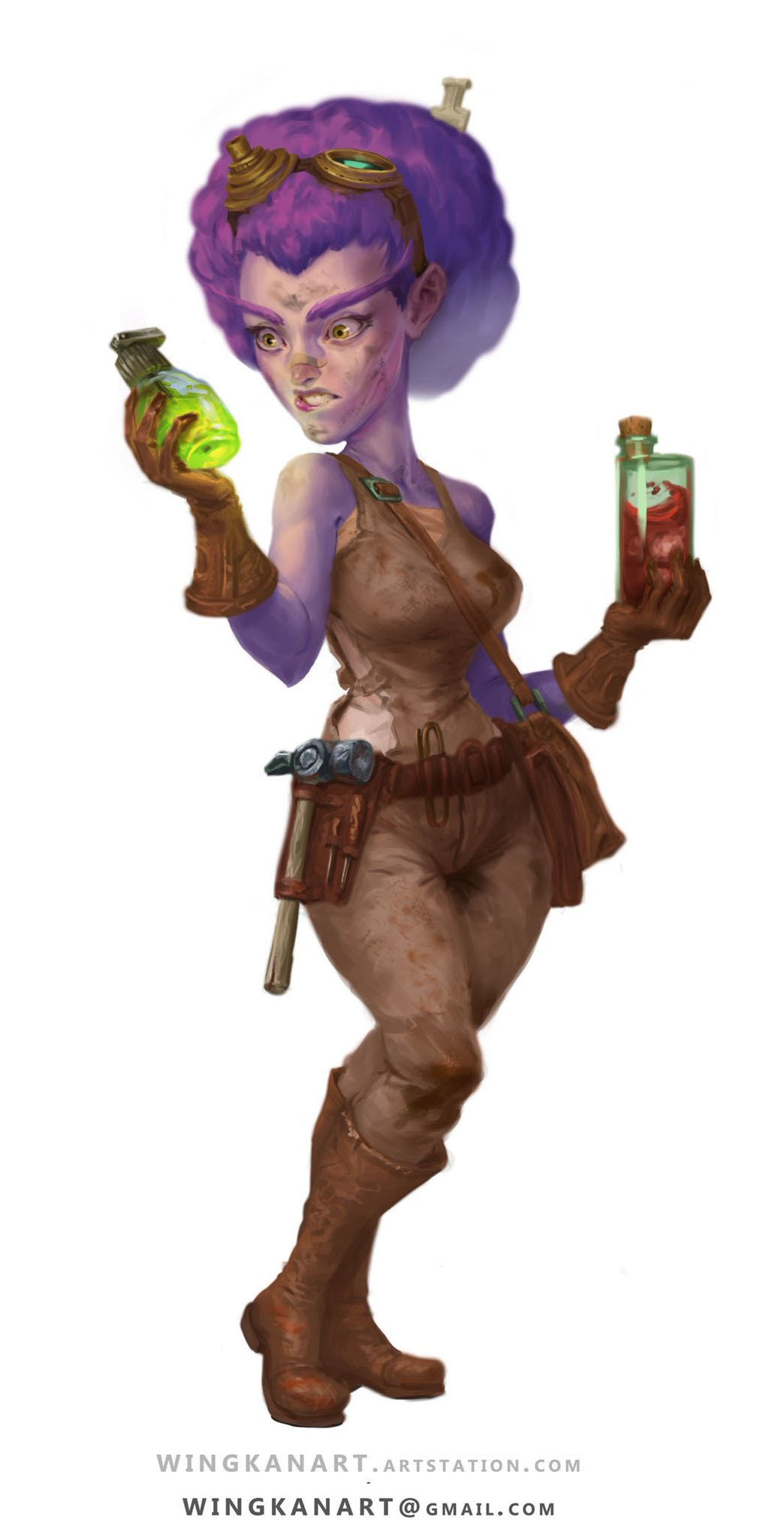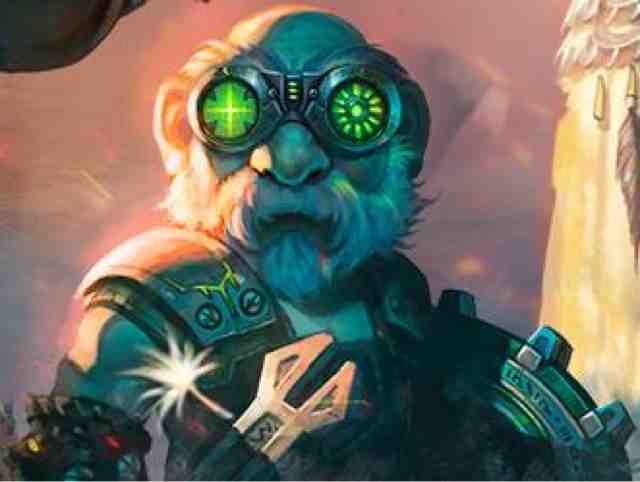Gnomes in D&D.
I don’t understand why they exist.
It feels like we’ve spent 30+ years trying to figure out a way to make them meaningfully different from dwarves and pretty much failing except insofar as they are now sometimes halflings with pointy years.

(If you’re first thought was, “Dwarves have beards and gnomes don’t! They’re totally different!” you may want to bail out now. This is probably not the post for you.)
The best gambit was probably Dragonlance’s tinker gnomes, a memetic line of thought which culminates most distinctly with World of Warcraft. But it’s still lacking. Being technologically inclined isn’t exactly outside of the dwarven wheelhouse. Plus: A whole race that tinkers? Like, there are no gnome farmers? Or tax collectors? Or seamstresses?
So, without further ado, here’s a bevy of ideas for making gnomes unique enough to justify their existence.
MAKE THEM TINY. Like 1 to 1.5 feet tall. The size of a garden gnome. Playing them is now a unique experience compared to any other common PC race.
 GNOMES DON’T ACTUALLY EXIST. They’re just dwarves who live outside instead of under the mountain. Your choice whether “gnome” is actually a racial slur or a self-embraced cultural identity. Or both.
GNOMES DON’T ACTUALLY EXIST. They’re just dwarves who live outside instead of under the mountain. Your choice whether “gnome” is actually a racial slur or a self-embraced cultural identity. Or both.
HALF-SPECIES. The result of dwarves and halflings interbreeding. They really ARE just dwarves without beards and/or halflings with pointy ears.
(“3rd Edition halflings already have pointed ears!” That’s probably where the gnomes get it from, then.)
HALF-SIZED SPECIES. What if halflings are half-sized humans and gnomes are half-sized elves?
This raises questions. Is there an entire echelon of half-sized races? Like, sure, goblins are obviously the half-sized orcs. But where are the half-sized dwarves? Or are the dwarves actually the half-sized ones?
DWARVEN SUB-CULTURE. Sort of the equivalent of emo/goth teens. Gnomes are a youth cultural movement that shave their beards and get obsessed with gadgetry. Older dwarves try not to let their eyes roll out of their heads when talking about them.
GODDESS SHARDS
Long ago the Gods of Magic slew the Goddess of Science & Technology (which is why D&D-land no longer advances technologically and is suck in a perpetual Renaissance). The shattered shards of the Goddess fell to the earth and manifested as the manic, technology-obsessed gnomes.
 Gnome farmers? They exist. But none of them just farm the earth in an orderly fashion. Every one of them has a unique scheme — elaborate hydroponic projects, subterranean growing caverns, legions of mechanical scurriers who harvest the fields like plague locusts.
Gnome farmers? They exist. But none of them just farm the earth in an orderly fashion. Every one of them has a unique scheme — elaborate hydroponic projects, subterranean growing caverns, legions of mechanical scurriers who harvest the fields like plague locusts.
Gnome tax collectors? The creepiest is probably the one who created a panopticon of clockwork tax-spiders who watch every transaction and exact their coin on the spot. What makes it worse is that the government they once served fell a generation ago and no one is entirely sure what the tax-spiders are doing with the taxes they collect any more.
Every gnome has a sliver of a dead goddess manifested in their brain. Every gnome constantly lives with the gibbering madness of her shattered, god-like consciousness whispering like a livewire as a commentary to their inner monologue.
Furthermore, inspired by Wing Kan’s art over there, I’ll also push the idea that gnomes are neon-hued in skin and hair. (Usually matching, but sometimes not for reasons gnomes struggle to explain.)














It feels tempting to adapt the “Open Your Brain” move from Apocalypse World for the goddess shard gnomes, modeling what happens when they start asking questions of the mad goddess within.
Thanks for your ideas. In my campaign, all gnomes are like “David the Gnome”: a benevolent and nature oriented version of dwarves.
“But where are the half-sized dwarves? Or are the dwarves actually the half-sized ones?”
– Let me posit that, since D&D dwarves are just a bit shorter than humans but burlier, that dwarves are the half-sized version of giants.
If you want to expand that in a fun way, you could have a world where the dwarven “racial enmity” toward giants is a feature common to all full/half pairs, so that halflings as a rule hate humans, gnomes hate elves, goblins hate orcs, etc.
And then you could explore the ways in which that hatred manifests: dwarves live in the ground beneath giants and kneecap them when they meet; halflings shun and mock humans; gnomes pursue science in an attempt to surpass the elves’ magics; goblins bicker with orcs at every opportunity and are rewarded for their trouble with brutal subjugation.
It isn’t that half sized races ALWAYS hate their counterpart, but that they always have some dial set to -100%, a twisted mockery of their progenitor. Elves are intelligent, fey, and “NATURAL” so gnomes are intelligent, fey, and technic. Giants are burly,greedy, and Savage, dwarves are burly, greedy city-builders. Humans are buck wild so halflings are a sedate monoculture
Paizo addressed this (10 years ago) in Pathfinder. Gnomes are distant relatives of the fey. They are eccentric and capricious, have innate magical powers, and their hair and skin comes in a variety of bright colors. They’re taking this a step further in the upcoming Pathfinder 2nd Ed.: gnomes crave and require a steady diet of some sort of creative stimuli or novel experiences. When deprived for too long of such things, they start to undergo something known as “the bleaching”, in which their hair turns white and they start to go mad.
The thing that’s always puzzled me about D&D is why half-elves are included among the core PC races, when there are also elves. THAT’s the one that seems redundant to me. I feel that new players might be confused as to why they would pick one over the other when creating their character. I mean, here’s a conversation that has never happened, ever:
DM: So, have you given some thought to what kind of character you’d like to play?
Player: Well, I think Legolas is cool. I wanna play a character like him.
DM: Ok, great! So, let’s choose Elf as your race…
Player: Woah, woah, woah! Let’s not get carried away here. Couldn’t I just be, like, half an elf?
Classic D&D Gnomes at least had the kinda like dwarves but they can cast spells niche, then 3rd edition took that away when they got rid of class restrictions.
So we settled on basically a “Wood Dwarf”, standard Gnome size, but living like David the Gnome, in tune more with woodcraft and animals.
Gnomes to me are just one of those things, like Monks and Dragonborn, that don’t really fit D&D but can never be taken out for nostalgic or backwards-compatibility reasons. That’s not to say I don’t like them, but I don’t think they gel with the rest of the (implied) setting.
I was toying with some ideas for a fantasy world recently, and rehashing the old “how do I make the ‘classic’/trope races different and interesting?” thing.
An idea I had for gnomes was that while dwarves were diurnal (they’d lost their great cities and lived aboveground, and were nomads who built and maintained most of the roads in the land) gnomes were nocturnal and tended to dwell in forests and woods without artificial structures; they were related to dwarves, though, and commonly called “night dwarves.” They had a penchant for nature and enchantment.
I feel a bit gauche that my first post on your blog (long-time lurker) is self-promotion, but I actually did a retrospective on the gnome and tiefling races on my blog – https://dungeonantology.com/2017/10/20/on-tieflings-and-gnomes/ and it’s effectively a direct offshoot off of what this post is about.
My impression is you are better read than I am on TTRPG history, so I don’t know if it will actually give you anything new, but on the offhand chance it would, thought I’d mention it! 🙂
I do think that 4e did the most to make gnomes unique, out of all the editions, and that the only way they were able to do that was to make two entirely new planes…and even that still leaves them wanting.
They will forever remain the “added just cuz” race, I think. I wouldn’t lose sleep if 6e got rid of them.
The 1e Monster Manual hinted at a link between dwarves and fire giants based on their proportions, so maybe dwarves are 1/3-size fire giants.
I think originally Halflings were like fighter-thieves, elves were fighter-magic-users, gnomes were thief magic-users. Or some forced games dynamic like that. They never had much point when race as class ended with AD&D.
An old(and sadly never completed) article series called The New World on the OOTS website is what comes to mind for me when discussing making gnomes stand out more. The series as a whole is great, but part 3 raises the topic of gnomes and part 8 discusses them in detail. http://www.giantitp.com/Gaming.html
Those are some great ideas! Though under “Goddess Shards” you addressed gnome farmers and tax-collectors, but you left out seamstresses. So let me offer this suggestion: you know how the mechanized loom was one of the first major breakthroughs of the Industrial Revolution? That seems like just the sort of thing a tech-crazy gnome seamstress would come up with. Also, the sewing machine.
Here are a couple more takes on gnomes that I favor. The first is an interpretation I came up with for a steampunk setting loosely inspired by the computer game Arcanum. In this setting, gnomes are largely urban, less clannish than other demihuman races, and excel at jobs that require charisma or intelligence. A gnome might be a politician, a banker, a professor, a showman, an inventor, or a snake-oil salesman.
In a more traditional fantasy setting, I’d go the other direction and embrace the idea of gnomes as forest-dwelling, trickster fey. I also like the idea of a creation myth linking dwarves, giants and gnomes: dwarves are masters of metal, giants are masters of stone, and gnomes are masters of earth who build elaborate warrens.
Either way, I thought that 3e gnomes should have gotten a bonus to Intelligence rather than Constitution, and I’m glad that 5e went that route. (I’ve never understood why the Monster Manual is full of creatures with genius-level intellects, and yet not one of the standard PC races prior to 4e had an Int bonus.)
Doodpants: I think we can blame Tolkien for half-elves, although according to Wikipedia, there are also precedents in Norse mythology. More recently, Tanis Half-Elven probably boosted their popularity. What *I’d* like to know is why half-dwarves have never caught on.
I think gnomes are cool. They just become redundant when you have them in the same setting as halflings. But of the two, I think gnomes are the far more interesting ones.
I also think that when you have gnomes in your campaign, dwarves become somewhat pointless as well. Again, gnomes seem much more interesting than bland generic dwarves.
I wholeheartedly agree gnomes existence needs to be justified. This was a very satisfying post. The D&D kitchen sink of race options doesn’t work for every campaign. I feel the PHB and DMG should provide a disclaimer saying that each of the non-standard races need DM approval, in addition to suggesting ideas for how to justofy them in a campaign.
@Confanity: Excellent ideas I’m going to mercilessly take and run with.
Dwarves are quarter-sized giants, actually. That’s why they share so many linguistic and cultural connections. (Moradin = Annam. Wake up, sheeple!)
The ethos of the D&D rules (especially the monster manuals) has always been “include everything!” But it’s often a strong move for particular campaigns to deliberately exclude some stuff. Pruning the gods to one pantheon is common, and excluding psionics, splatbooks, “eastern” classes, but I think limiting or altering the playable races is a strong one that’s under-used. “This game we’re not using any of the Tolkien races, just Lizardmen, Pygmies, and Half-Ogres.” It does commit you to some re-writing of 3rd-party modules that you were probably going to have to do anyway, but otherwise it’s pretty easy.
I’m currently in a game where gnomes are defined by their lack of identity: all the established gnome societies were wiped out or enslaved by other races, so gnome PCs are orpans trying to rebuild a culture lost before they were born.
So far, it seems to involve ninjas.
Door #2 for me–almost. Gnomes live symbiotically with dwarves, with dwarves mostly below ground and gnomes above. I even have a new hybrid race, the dwarf-gnome (really clever name, I know), so the two races are different. While PCs can be anything they want, seeing dwarves above ground in my campaign is unusual and always attracts attention.
My two cents on this as a Final Fantasy fan:
Tarutaru are gnomes.
Lalafell are halflings.
Which is to say, the subtle differences between FFXI’s tarutaru and FFXIV’s lalafell strike me as fairly similar — magical versus dexterous, scholarly versus worldly, scheming for ultimate power versus scheming for vast wealth.
Yup, so in my 1e setting I lean into the similarity to make dwarves even “drawfier”.
Dwarves live underground almost exclusively, and gnomes live both above and below ground, making gnomes the major go-between for dwarves and the surfacefolk. There is even a new race, the incredibly imaginatively named “dwarf-gnome”, which is exactly what it sounds like.
From a PC perspective, you can still be any race you want, but dwarves above ground are rare and will be noticed, while gnome NPCs are probably more common in my setting. This also makes dwarfish life more of a mystery to most surfacefolk, putting them on par with how elves are often treated.